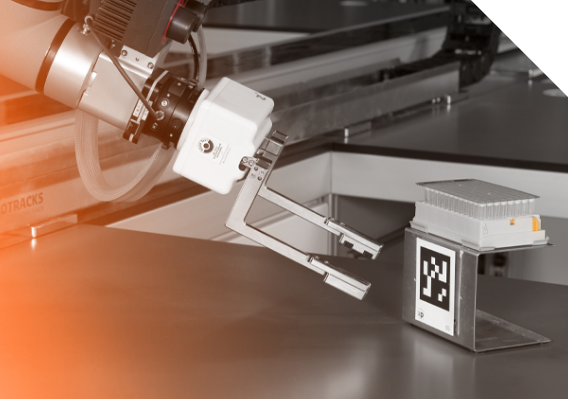What are Cobots? Collaborative robots explained

Share this article
Collaborative robots (a name that is frequently shortened to ‘Cobots’) are a revolutionary step in the automation world. At Astech, we help laboratories, manufacturers, pharmaceutical settings and more introduce Cobots into their workflows to improve efficiency and accuracy across critical processes.
Created to work seamlessly alongside human workforces, the practical applications for Cobots are endless, especially in environments that require a number of repetitive, logical tasks to be completed.
In this article, our experts explain what Cobots are, and how they can be utilised.
What is a Cobot?
To put it simply, a Cobot is a robot that is designed and programmed to work collaboratively with human employees. They tend to have a smaller footprint than traditional machines, and their intuitive designs remove the need for separate robot and human workspaces. They are best suited to repetitive and physically demanding exercises, freeing up time and resources for technicians, engineers, and laboratory workers to focus on tasks that require more human insight.
Key Cobot features
Different manufacturers will have varying features included within their Cobot builds that can be adjusted depending on what they are needed for. The following features are the most notable of Astech’s RAMP (Cobots) to give you an idea of what is possible.
- A safety-centric design - greater safety is one of the most desirable features of Cobots, making them a sought-after investment. Ramp Cobots have advanced sensors and controls to keep human operators out of harm's way
- Optimal workflow and productivity features - Cobots make it possible to enhance workflows and reduce error margins for greater throughput
- Seamless integration - Cobots are designed to seamlessly integrate into any workflow, no matter how complex or specialised
- Intuitive and user-friendly - they have user-friendly interfaces to allow workers to easily interact with them
- Varied applications and flexibility - they can be adapted to different tasks depending on where they are needed most, making them a long-term, sustainable investment that changes in cohesion with their environments
Differences between Cobots and robots
Collaborative robots and traditional robots both have their places in factories and production lines, but understanding the differences between the two is important to technicians who are considering integrating a new machine into their workflow.
Keep in mind that different robots and Cobots will have varying levels of capability, the following is generic guidance.
Cobots/Collaborative Robot Features
- Collaborative features - Built with collaboration in mind
- User interface - Designed to be user-friendly and easy to use by the whole workforce with minimal training
- Applications - Suitable for more agile, repetitive tasks that involve handling products or materials. Most Cobots can be reprogrammed to take on different tasks
- Safety - In-built safety features as standard to allow seamless, collaborative working between humans and robots
Traditional Robot Features
- Collaborative features - Purpose built to work independently without interaction with workforce
- User interface - Generally requires expertise to use and program, specialist training usually needed
- Applications - Suited to heavy-duty tasks such as welding and machining. Purpose built and programmed for specific tasks, harder to repurpose
- Safety - Less intuitive safety features, physical barriers necessary
Industries that benefit from Cobots
Any environment that utilises robotics in their processes can integrate cobots into their setting, but these are some industries that we have seen benefit from introducing these collaborative workhorses into their workflows.
1) Pharmaceuticals
Capable of automating process critical, precise, repeatable tasks within delicate lab environments. This speeds up research and development, and enhances drug manufacturer, packaging and quality control.
Learn more about pharmaceutical automation.
2) Manufacturing
Automation of tasks such as loading and unloading, packaging, and can function in different production line roles. Ensures high product quality is maintained and improves productivity.
Learn more about manufacturing automation.
3) Medical Devices
Automated the assembly, testing, sterilisation, and packaging of medical devices - creating a smaller margin of error and allowing for greater accuracy.
Learn more about medical device automation.
4) Laboratories
The use for cobots in laboratories is extensive, and can include sample preparation, liquid handling, researching, testing, and more - accelerating discoveries and streamlining resource usage.
Learn more about laboratory automation
Use Cobots to revolutionise your workflow
This oversight of what Cobots are, and how they are being used merely scratches the surface on how robotics and automotive technology is evolving within collaborative workspaces.
Cobots are becoming increasingly more popular as the technology behind them advances, transforming time consuming processes into efficient tasks.
The future looks bright for Cobots, and as they filter their way into mainstream usage, you can expect to see deeper integrations - with many considering how AI can be utilised alongside their Cobot workforce to create a truly intuitive workflow.
The industries adapting this technology continue to grow, branching out from their ‘usual’ settings into retail and logistics, construction, and even educational placements.
Whatever use you can think of for a Cobot, the team at Astech are armed with the knowledge needed to help your initial concept become a reality.


